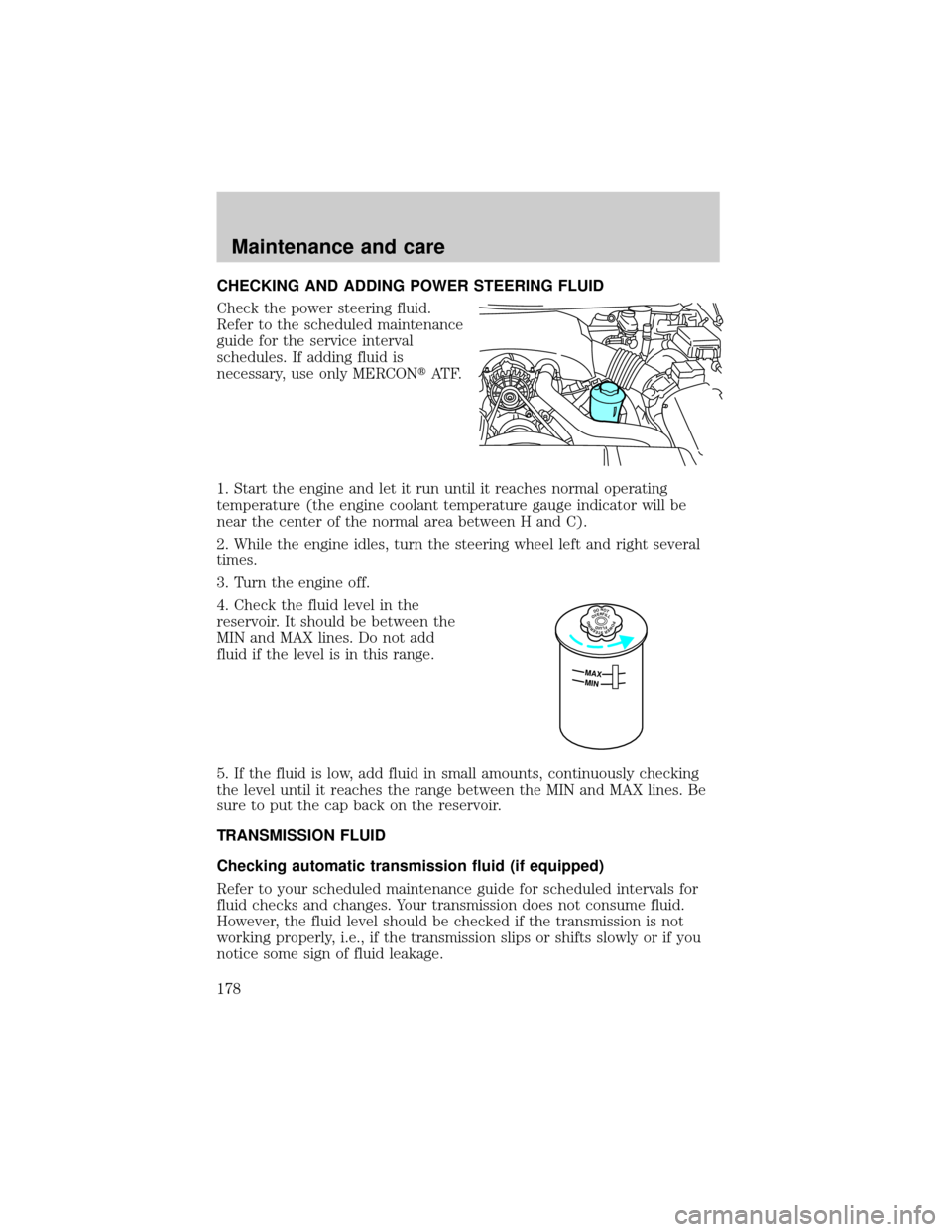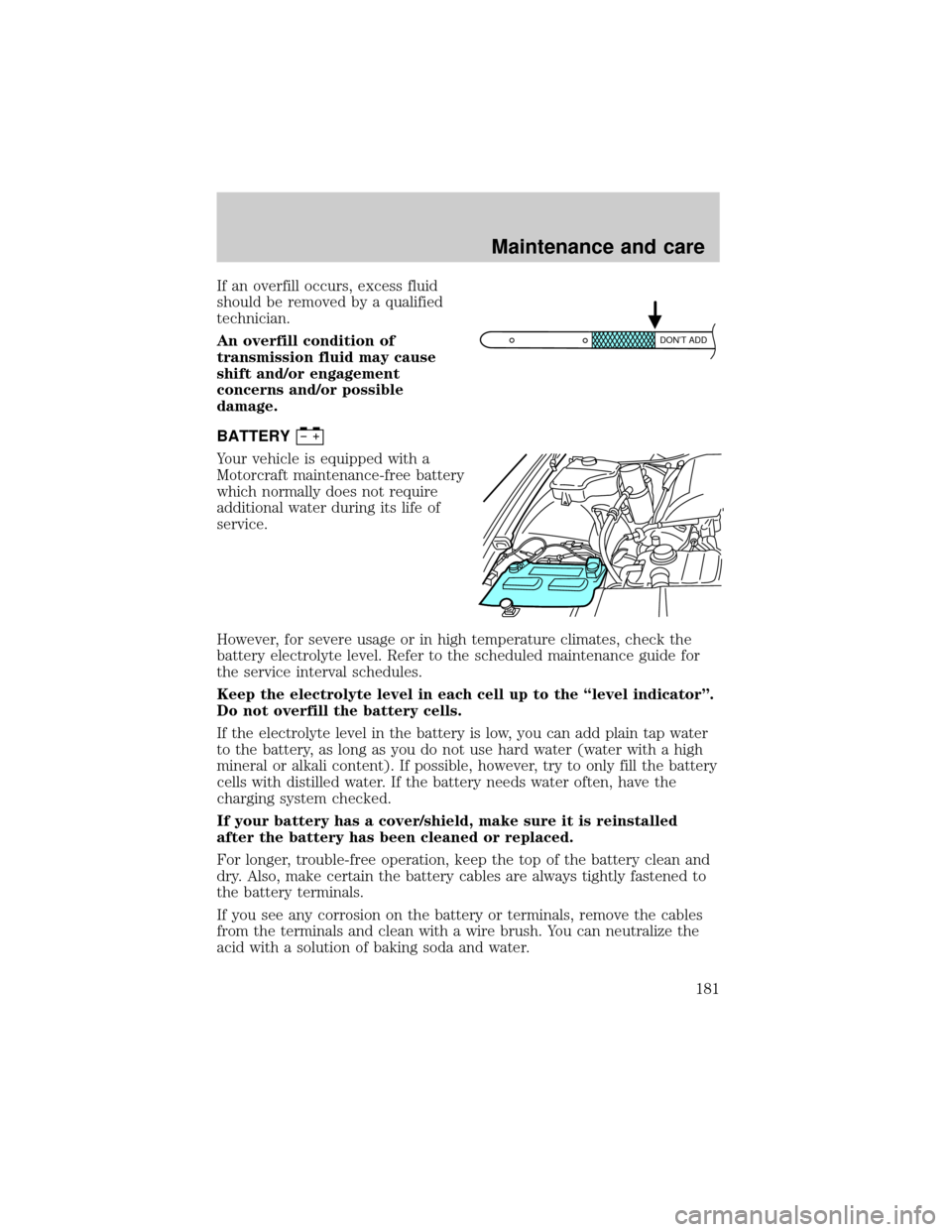2001 LINCOLN TOWN CAR check transmission fluid
[x] Cancel search: check transmission fluidPage 178 of 240

CHECKING AND ADDING POWER STEERING FLUID
Check the power steering fluid.
Refer to the scheduled maintenance
guide for the service interval
schedules. If adding fluid is
necessary, use only MERCONtAT F.
1. Start the engine and let it run until it reaches normal operating
temperature (the engine coolant temperature gauge indicator will be
near the center of the normal area between H and C).
2. While the engine idles, turn the steering wheel left and right several
times.
3. Turn the engine off.
4. Check the fluid level in the
reservoir. It should be between the
MIN and MAX lines. Do not add
fluid if the level is in this range.
5. If the fluid is low, add fluid in small amounts, continuously checking
the level until it reaches the range between the MIN and MAX lines. Be
sure to put the cap back on the reservoir.
TRANSMISSION FLUID
Checking automatic transmission fluid (if equipped)
Refer to your scheduled maintenance guide for scheduled intervals for
fluid checks and changes. Your transmission does not consume fluid.
However, the fluid level should be checked if the transmission is not
working properly, i.e., if the transmission slips or shifts slowly or if you
notice some sign of fluid leakage.
DONOTOVERFILLPOWERSTEERINGFLUID
MAX
MIN
Maintenance and care
178
Page 179 of 240
![LINCOLN TOWN CAR 2001 Owners Manual Automatic transmission fluid expands when warmed. To obtain an
accurate fluid check, drive the vehicle until it is at normal operating
temperature (approximately 30 km [20 miles]). If your vehicle has LINCOLN TOWN CAR 2001 Owners Manual Automatic transmission fluid expands when warmed. To obtain an
accurate fluid check, drive the vehicle until it is at normal operating
temperature (approximately 30 km [20 miles]). If your vehicle has](/manual-img/15/7044/w960_7044-178.png)
Automatic transmission fluid expands when warmed. To obtain an
accurate fluid check, drive the vehicle until it is at normal operating
temperature (approximately 30 km [20 miles]). If your vehicle has been
operated for an extended period at high speeds, in city traffic during hot
weather or pulling a trailer, the vehicle should be turned off for about 30
minutes to allow fluid to cool before checking.
1. Drive the vehicle 30 km (20 miles) or until it reaches normal operating
temperature.
2. Park the vehicle on a level surface and engage the parking brake.
3. With the parking brake engaged and your foot on the brake pedal,
start the engine and move the gearshift lever through all of the gear
ranges. Allow sufficient time for each gear to engage.
4. Latch the gearshift lever in P (Park) and leave the engine running.
5. Remove the dipstick, wiping it clean with a clean, dry lint free rag. If
necessary, refer toIdentifying components in the engine compartment
in this chapter for the location of the dipstick.
6. Install the dipstick making sure it is fully seated in the filler tube.
7. Remove the dipstick and inspect the fluid level. The fluid should be in
the designated area for normal operating temperature or ambient
temperature.
Low fluid level
Do not drive the vehicle if the fluid
level is at the bottom of the dipstick
and the ambient temperature is
above 10ÉC (50ÉF).
Correct fluid level
The transmission fluid should be checked at normal operating
temperature 66ÉC-77ÉC (150ÉF-170ÉF) on a level surface. The normal
operating temperature can be reached after approximately 30 km
(20 miles) of driving.
DON’T ADD
Maintenance and care
179
Page 180 of 240

You can check the fluid without driving if the ambient temperature is
above 10ÉC (50ÉF). However, if fluid is added at this time, an overfill
condition could result when the vehicle reaches normal operating
temperature.
The transmission fluid should be in
this range if at normal operating
temperature (66ÉC-77ÉC
[150ÉF-170ÉF]).
The transmission fluid should be in
this range if at ambient temperature
(10ÉC-35ÉC [50ÉF-95ÉF]).
High fluid level
Fluid levels above the safe range
may result in transmission failure.
An overfill condition of transmission
fluid may cause shift and/or
engagement concerns and/or
possible damage.
High fluid levels can be caused by
an overheating condition.
Adjusting automatic transmission fluid levels
Before adding any fluid, make sure the correct type is used. The type of
fluid used is normally indicated on the dipstick and also in the
Lubricant specificationssection in theCapacities and specifications
chapter.
Use of a non-approved automatic transmission fluid may cause
internal transmission component damage.
If necessary, add fluid in 250 ml (1/2 pint) increments through the filler
tube until the level is correct.
DON’T ADD
DON’T ADD
DON’T ADD
Maintenance and care
180
Page 181 of 240

If an overfill occurs, excess fluid
should be removed by a qualified
technician.
An overfill condition of
transmission fluid may cause
shift and/or engagement
concerns and/or possible
damage.
BATTERY
Your vehicle is equipped with a
Motorcraft maintenance-free battery
which normally does not require
additional water during its life of
service.
However, for severe usage or in high temperature climates, check the
battery electrolyte level. Refer to the scheduled maintenance guide for
the service interval schedules.
Keep the electrolyte level in each cell up to the ªlevel indicatorº.
Do not overfill the battery cells.
If the electrolyte level in the battery is low, you can add plain tap water
to the battery, as long as you do not use hard water (water with a high
mineral or alkali content). If possible, however, try to only fill the battery
cells with distilled water. If the battery needs water often, have the
charging system checked.
If your battery has a cover/shield, make sure it is reinstalled
after the battery has been cleaned or replaced.
For longer, trouble-free operation, keep the top of the battery clean and
dry. Also, make certain the battery cables are always tightly fastened to
the battery terminals.
If you see any corrosion on the battery or terminals, remove the cables
from the terminals and clean with a wire brush. You can neutralize the
acid with a solution of baking soda and water.
DON’T ADD
Maintenance and care
181
Page 231 of 240

A
Accessory delay ..........................74
Air bag supplemental restraint
system ................................110, 115
and child safety seats ............112
description ......................110, 115
disposal ....................................118
driver air bag ..................112, 116
indicator light .............9, 114, 117
operation .........................112, 116
passenger air bag ...........112, 116
side air bag ..............................115
Air cleaner filter ...............183, 212
Air conditioning ..........................27
automatic temperature
control system ..........................27
Air suspension ...........................134
description ..............................134
warning light .............................13
Antifreeze (see Engine
coolant) .....................................171
Anti-lock brake system (see
Brakes) ..............................130±131
Audio system (see Radio) .........33
Automatic transmission
driving an automatic
overdrive .................................136
fluid, adding ............................178
fluid, checking ........................178
fluid, refill capacities ..............212
fluid, specification ..................215
Auxiliary power point .................59
Axle
lubricant specifications ..214±215
refill capacities ........................212
traction lok ..............................139B
Battery .......................................181
acid, treating emergencies .....181
charging system warning
light ............................................11
jumping a disabled battery ....158
maintenance-free ....................181
replacement, specifications ...212
servicing ..................................181
Belt minder ...............................106
Brakes ........................................130
anti-lock ...........................130±131
anti-lock brake system
(ABS) warning light .........10, 131
brake warning light ..................10
fluid, checking and adding ....170
fluid, refill capacities ..............212
fluid, specifications .........214±215
lubricant specifications ..214±215
pedals (see Power adjustable
foot pedals) ...............................58
shift interlock ..........................135
Break-in period .............................3
C
Capacities for refilling fluids ....212
Cassette tape player ...................41
CD changer .................................53
Certification Label ....................218
Child safety restraints ..............118
child safety belts ....................118
Child safety seats ......................119
attaching with tether straps ..123
in front seat ............................121
in rear seat ..............................121
Cleaning your vehicle ...............206
Index
231
Page 232 of 240

engine compartment ..............209
exterior ....................................207
exterior lamps .........................208
instrument cluster lens ..........210
instrument panel ....................210
interior .............................210±211
mirrors .....................................208
plastic parts ............................208
safety belts ..............................211
washing ....................................206
waxing .....................................207
wheels ......................................208
windows ..................................210
wiper blades ............................208
woodtone trim ........................210
Climate control (see Air
conditioning or Heating) ............27
Clock ................................39, 53, 58
Compass, electronic
calibration .................................20
set zone adjustment ...........19±20
Console
rear ............................................76
Controls
power seat .................................92
steering column ........................65
Coolant
checking and adding ..............171
coolant temperature light ........12
refill capacities ................175, 212
specifications ..................214±215
Cruise control (see Speed
control) ........................................62
Customer Assistance ................145
Ford accessories for your
vehicle .....................................226
Ford Extended Service
Plan ..........................................219Getting assistance outside the
U.S. and Canada .....................225
Getting roadside assistance ...145
Getting the service
you need .................................219
Ordering additional owner's
literature .................................228
The Dispute Settlement
Board .......................................222
Utilizing the
Mediation/Arbitration
Program ...................................225
D
Daytime running lamps
(see Lamps) ................................26
Defrost
rear window ..............................33
Dipstick
automatic transmission
fluid ..........................................178
engine oil .................................167
Doors
door ajar warning .....................12
lubricant specifications ..........214
Driving under special
conditions
through water .........................144
E
Emergencies, roadside
jump-starting ..........................158
Emission control system ..........197
Engine ................................215±216
check engine/service engine
soon light ....................................8
cleaning ...................................209
Index
232
Page 236 of 240

extension assembly ................105
for adults .........................101±103
for children .............................118
lap belt ....................................104
Occupant Classification
Sensor ........................................98
warning light and
chime .....................9, 14, 105±106
Safety seats for children ..........119
Seat belts (see Safety
restraints) ....................................96
Seats ............................................92
child safety seats ....................119
cleaning ...........................210±211
easy access/easyout feature ....95
heated ........................................94
memory seat .................76, 84, 96
SecuriLock passive anti-theft
system ....................................88, 90
Servicing your vehicle ..............164
Spark plugs,
specifications .............212, 215±216
Specification chart,
lubricants ...........................214±215
Speed control ..............................62
Speedometer ...............................16
Starting your vehicle ........126, 128
jump starting ..........................158
Steering
speed sensitive .......................134
Steering wheel
controls ......................................65
tilting .........................................60T
Tires ...........................154, 185±187
changing ..................................154
checking the pressure ............187
replacing ..................................188
rotating ....................................187
snow tires and chains ............188
tire grades ...............................186
treadwear ................................186
Towing .......................................141
recreational towing .................143
trailer towing ..........................141
wrecker ....................................163
Traction control ..................59, 133
active light ................................14
how to enable/disable ............133
off light ......................................13
Traction-lok rear axle ...............139
Transmission .............................135
fluid, checking and adding
(automatic) .............................178
fluid, refill capacities ..............212
lubricant specifications ..214±215
Trunk ...........................................91
remote release ....................72, 81
Turn signal ......................11, 15, 60
V
Vehicle dimensions ...................216
Vehicle Identification Number
(VIN) ..........................................218
Vehicle loading ..........................139
Ventilating your vehicle ...........129
Index
236